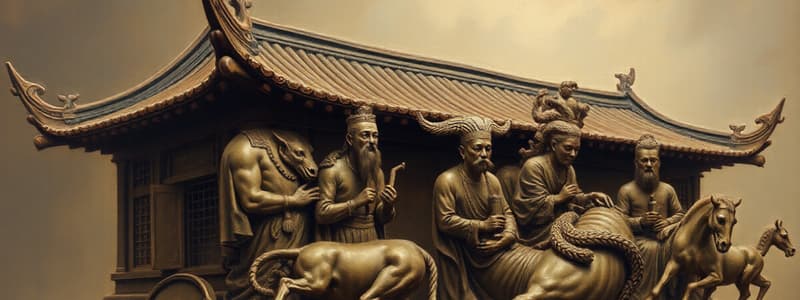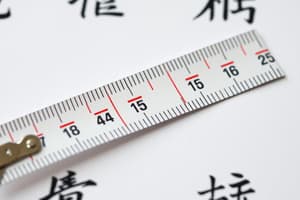Podcast
Questions and Answers
What is the Mandate of Heaven also referred to as?
What is the Mandate of Heaven also referred to as?
- Tianming (correct)
- Tianbao
- Tianwen
- Tianren
Who are the Three Sovereigns?
Who are the Three Sovereigns?
- Shen Nong, Zhu Rong, Fuxi/Nuwa (correct)
- Huangdi, Zhuan Xu, Ku
- Wang Mang, Liu Bang, Sun Quan
- Yu, Jia, Yao
Which dynasty is associated with the legendary figures Yu and Jia?
Which dynasty is associated with the legendary figures Yu and Jia?
- Tang Dynasty
- Xia Dynasty (correct)
- Shang Dynasty
- Han Dynasty
What does the concept of li represent?
What does the concept of li represent?
Which two types of tomb structures are highlighted?
Which two types of tomb structures are highlighted?
What is the significance of the mingqi in funerary practices?
What is the significance of the mingqi in funerary practices?
What significant item is notably found in Mawangdui Tomb No.1?
What significant item is notably found in Mawangdui Tomb No.1?
Which mythical figure is associated with the idea of immortality?
Which mythical figure is associated with the idea of immortality?
What significant change occurred in ancestral worship during the Eastern Zhou period?
What significant change occurred in ancestral worship during the Eastern Zhou period?
What are bronze vessels from the Shang dynasty known for?
What are bronze vessels from the Shang dynasty known for?
What is the term 'taotie' associated with?
What is the term 'taotie' associated with?
What does the concept of 'Zu' refer to in the context of funerary practices?
What does the concept of 'Zu' refer to in the context of funerary practices?
In which dynasty was the Wu Liang Shrine constructed?
In which dynasty was the Wu Liang Shrine constructed?
What does the term 'mutual dependence' signify in the context of familial lineage?
What does the term 'mutual dependence' signify in the context of familial lineage?
What were the primary materials used for making ink rubbings in funerary art?
What were the primary materials used for making ink rubbings in funerary art?
What does the expansion of orthodox ritual codes during the Northern Song period imply?
What does the expansion of orthodox ritual codes during the Northern Song period imply?
What does the design of the Mawangdui name banner primarily represent?
What does the design of the Mawangdui name banner primarily represent?
Which of the following materials is NOT mentioned as having symbolic significance in funerary objects?
Which of the following materials is NOT mentioned as having symbolic significance in funerary objects?
What is depicted on the foot panel of one of Lady Dai’s coffins?
What is depicted on the foot panel of one of Lady Dai’s coffins?
What is the primary purpose of the figurines found in Mawangdui tomb no.1?
What is the primary purpose of the figurines found in Mawangdui tomb no.1?
What does jade symbolize in the context of ancient Chinese funerary practices?
What does jade symbolize in the context of ancient Chinese funerary practices?
Which characterization best describes the structure of the Cangshan tomb according to the content?
Which characterization best describes the structure of the Cangshan tomb according to the content?
What scene is depicted on the east wall of the Cangshan tomb?
What scene is depicted on the east wall of the Cangshan tomb?
In the context of the information provided, which description is least applicable to the concept of 'Immortality after death'?
In the context of the information provided, which description is least applicable to the concept of 'Immortality after death'?
Flashcards are hidden until you start studying
Study Notes
Overview of Early Funerary Art in China
- Significant development of funerary art occurred around the Yellow River and Yangzi River regions.
- Bronze vessels, such as the square ding from the mid-Shang dynasty, held both utilitarian and ceremonial purposes.
Ancestral Worship
- Shift from a collective ancestor concept to individual familial worship during the Eastern Zhou period (770-256 BCE), moving from lineage temples to family graveyards.
- The Northern Song dynasty (960-1127 CE) expanded ritual practices, making them accessible to ordinary people.
Wu Liang Shrine
- Wu Liang Shrine, dating back to 151 CE, provides insights into early funerary practices and ancestral veneration.
- Layout and pictorial reliefs depict themes vital to ancestral worship, including political ideals and immortality.
Key Themes in Funerary Art
- Mandate of Heaven: Reflects political and cosmic order; used to justify rule.
- Mythical Figures: Depicts figures like the Queen Mother of the West, symbolizing immortality and divine authority.
- Human History: Represents the Three Sovereigns and Five Emperors, linking lineage to divine heritage.
Importance of Funerary Rites
- Funerary rites shaped societal norms surrounding death, influencing code creation for tomb construction and funerary art.
- The concept of li emphasized proper rituals and decorum in family ceremonies.
Mortuary Discourse
- Dualism between the hun (heavenly soul) and po (earthly soul) impacted burial practices and the types of grave goods included.
- Distinction between practical articles (yongqi) and spirit articles (mingqi).
Tomb Structures
- Two main tomb designs: vertical pits (earlier) and horizontal chambers.
- The Mawangdui Tomb No. 1, dating back to the 2nd century BCE, exemplifies elaborate burial practices with multiple coffins and grave goods.
Lady Dai's Tomb
- Lady Dai's tomb included richly decorated coffins and diverse grave goods symbolizing status and afterlife needs.
- The intricate depiction of immortality and deities on her coffins illustrates beliefs about the afterlife.
Material Culture in Funerary Contexts
- Specific materials symbolize different stages of existence: wood (mortal life), stone (endurance), and jade (purity and divinity).
- Jade objects, such as bi-discs from around 2000 BCE, served both practical and ceremonial purposes.
Iconography and Afterlife Visions
- Artworks in tombs, such as the Cangshan tomb, depict dynamic scenes of funery processions and immortal life, reinforcing the notion of life after death.
- Mt. Kunlun is depicted as a sacred space associated with immortality, underlining its importance in funerary iconography.
Cultural Reflection
- Early funerary art in China reflects evolving beliefs about life, death, and continuity, deeply intertwined with ancestral worship and societal rituals.
Studying That Suits You
Use AI to generate personalized quizzes and flashcards to suit your learning preferences.





